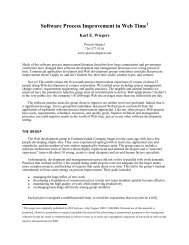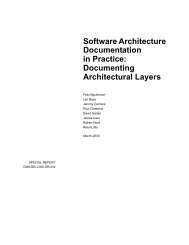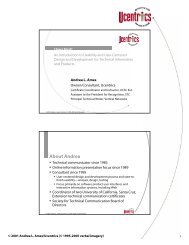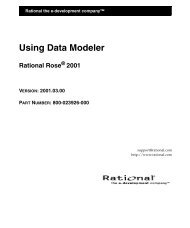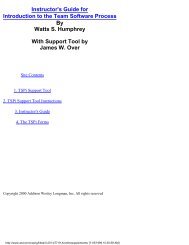RSI - A Structured Approach Use Cases and HCI Design
RSI - A Structured Approach Use Cases and HCI Design
RSI - A Structured Approach Use Cases and HCI Design
You also want an ePaper? Increase the reach of your titles
YUMPU automatically turns print PDFs into web optimized ePapers that Google loves.
The <strong>RSI</strong> <strong>Approach</strong> To <strong>HCI</strong> <strong>Design</strong> / <strong>Use</strong> Case Analysis Page 27 of 42<br />
• the specification model contains associations between Hotel <strong>and</strong> Customer, <strong>and</strong> between<br />
Customer <strong>and</strong> Reservation. Hotel is the anchor point on the specification model. This<br />
route is exploited on the interface: having selected a customer, clicking the 'reservations'<br />
button will refresh the listbox in the 'Reservations' section of the interface with the<br />
Customer's Reservations.<br />
A full description of the interface semantics of this dialog (including cross-references to<br />
underlying service use cases (not normally shown) is shown in the functionality section for<br />
this interface (see below). A diagrammatic format is used here to show the dynamics <strong>and</strong><br />
operation of the interface - text annotations are attached to the relevant parts of the interface<br />
dialog. An alternative approach is to list these annotations separately in a purely textual<br />
description. The most preferable approach is to demonstrate the dynamics in action using a<br />
screen prototype of the system. Such an approach may use a set of dummy services that return<br />
pre-defined (possibly configurable) sets of objects to be shown in the interface.<br />
W5a - <strong>RSI</strong> LONG PAPER [42 PAGES].doc( Rev: 5) - 03/09/00



